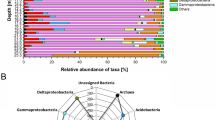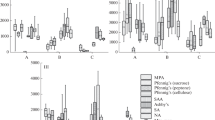Abstract
The taxonomic structure of microbial communities in the Late Pleistocene paleosols of different ages in the Central Russian Upland formed under contrasting climatic conditions were analyzed. The humic horizons of paleosols in the interstadial periods of the Early Valdai (105–95 kyr ago), Middle Valdai (33–24 kyr ago), Mikulino interglacial (130–117 kyr ago), and of the modern (Holocene) chernozem were considered. Microbial DNA was analyzed using quantitative PCR and 16S rRNA gene amplicon sequencing (DNA metabarcoding). The numbers of copies of archaeal, bacterial, and fungal genes gradually decreased with an increase in the soil age. All considered paleosols significantly differed from one another in the structure of their microbial communities. The Verrucomicrobia-to-Nitrospirae ratio was used as a diagnostic parameter reflecting the organic matter supply and the changes in carbon and nitrogen cycles. The Verrucomicrobia-to-Nitrospirae ratio in the interstadial soils was 140–200 times lower as compared with that in the modern soil (typical chernozem) and in the paleosols of the Mikulino interglacial. The share of gram-negative Proteobacteria and Acidobacteria increased with the soil age, whereas the share of gram-positive Actinobacteria and Firmicutes decreased. The modern chernozems and interglacial paleosols were characterized by similar values of microbial diversity, while the paleosols of the Valdai interstadial had significantly lower microbial diversity and species richness. Analysis of β-diversity showed that the paleosols of different types and ages maintained the difference in the structure and diversity of their microbial communities depending on the conditions of their formation. Thus, the microbial communities can be used as potential stratigraphic markers and indicators of different climatic conditions, under which the given paleosols were formed.





Similar content being viewed by others
REFERENCES
T. A. Arkhangel’skaya, M. V. Prokhorov, and M. A. Mazirov, “Annual dynamics of arable soils of paleocryogenic complexes of Vladimir Opol’e,” Kriosfera Zemli, No. 3, 80–86 (2008).
E. V. Blagodatskaya, O. S. Khokhlova, T.-H. Anderson, and S. A. Blagodatskii, “Extractable microbial DNA pool and microbial activity in paleosols of Southern Urals,” Microbiology (Moscow) 72, 750–755 (2003).
E. V. Blagodatskaya, M. V. Semenov, and A. V. Yakushev, Activity and Biomass of Soil Microorganisms under Conditions of Changing Environment (KMK, Moscow, 2016) [in Russian].
A. V. Borisov, T. S. Demkina, and V. A. Demkin, P-aleosols and Climate of Yergeni in the Bronze Age (4th–2nd Centuries BC) (Nauka, Moscow, 2006) [in Russian].
A. A. Velichko and T. D. Morozova, Climate and Landscapes of Northern Eurasia under Global Warming: Retrospective Analysis and Scenarios (GEOS, Moscow, 2010), pp. 120–127.
V. A. Demkin, N. N. Kashirskaya, T. S. Demkina, T. E. Khomutova, and M. V. El’tsov, “Paleosol studies of burial mounds in the Ilovlya River valley (the Privolzhskaya Upland),” Eurasian Soil Sci. 41, 115–127 (2008).
V. A. Demkin, A. V. Borisov, T. S. Demkina, T. E. Khomutova, B. N. Zolotareva, N. N. Kashirskaya, and E. V. Demkina, “Steppe pyramids of Eurasia: unique archive of Holocene paleosols,” in Paleosols and Indicators of Continental Weathering in the History of Biosphere (Paleontological Institute, Russian Academy of Sciences, Moscow, 2010), pp. 132–163.
T. S. Demkina, T. E. Khomutova, N. N. Kashirskaya, I. V. Stretovich, and V. A. Demkin, “Microbiological investigations of paleosols of archeological monuments in the steppe zone,” Eurasian Soil Sci. 43, 194‒201 (2010).
T. S. Demkina, T. E. Khomutova, N. N. Kashirskaya, I. V. Stretovich, and V. A. Demkin, “Characteristics of microbial communities in steppe paleosols buried under kurgans of the Sarmatian time (I–IV centuries AD),” Eurasian Soil Sci. 42, 778–793 (2009).
I. V. Ivanov, L. S. Pesochina, and V. M. Semenov, “Biological mineralization of organic matter in the modern virgin and plowed chernozems, buried chernozems, and fossil chernozems,” Eurasian Soil Sci. 42, 1109–1119 (2009).
A. O. Makeev, “Ecological role of paleosols in geological history,” in Soils in the Biosphere and Human Life (Moscow State Univ., Moscow, 2012), pp. 183–283.
O. E. Marfenina, D. S. Sakharov, A. E. Ivanova, and A. V. Rusakov, “Mycological complexes in Holocene and Late Pleistocene paleohorizons and in fragments of paleosols,” Eurasian Soil Sci. 42, 432–439 (2009).
T. D. Morozova, Development of Soil Cover of Europe in Late Pleistocene (Nauka, Moscow, 1981) [in Russian].
Guide for Scientific Field Excursions of the VII Congress of Dokuchaev Soil Society and All-Russian Scientific Conference with International Participation “Soil Science for Food and Ecological Safety of the Country,” Belgorod, August 15–22, 2010 (Moscow, 2016) [in Russian].
P. R. Pushkina and S. A. Sycheva, “Paleosols in depressions of the Central Russian Upland in the Early Valdai Time,” Eurasian Soil Sci. 47, 371–380 (2014). https://doi.org/10.1134/S1064229314050202
A. V. Rusakov and V. V. Novikov, “Biological activity in modern and buried soils of the historical center of St. Petersburg,” Microbiology (Moscow) 72, 103–109 (2003).
S. A. Sycheva, “Evolutionary analysis of Pleistocene of buried small erosion forms,” Geomorfologiya, No. 3, 31–38 (1996).
S. A. Sycheva and V. S. Gunova, “Analysis results of Late Pleistocene loess-soil complex in buried balka ystem of the Central Russian Upland,” Byull. Kom. Izuch. Chetvertichn. Perioda, Akad. Nauk SSSR, No. 65, 86–101 (2004).
S. A. Sycheva, “Late Pleistocene permafrost phenomena in periglacial area of the Russian Plain and their relation with paleosols,” in Problems of Paleogeography and Stratigraphy of Pleistocene (Moscow State Univ., Moscow, 2011), No. 3, pp. 228–237.
T. E. Khomutova, T. S. Demkina, and V. A. Demkin, “Estimation of the total and active microbial biomasses in buried subkurgan paleosoils of different ages,” Microbiology (Moscow) 73, 196–201 (2004).
T. E. Khomutova, T. S. Demkina, A. V. Borisov, and I. I. Shishlina, State of microbial communities in paleosols buried under kurgans of the desert-steppe zone in the Middle Bronze Age (27th–26th centuries BC) in relation to the dynamics of climate humidity, Eurasian Soil Sci. 50, 229–238 (2017). https://doi.org/10.1134/S1064229317020065
T. I. Chernov, A. D. Zheleznova, O. V. Kutovaya, A. O. Makeev, A. K. Tkhakakhova, N. A. Bgazhba, F. G. Kurbanova, A. V. Rusakov, T. A. Puzanova, and O. S. Khokhlova, “Comparative analysis of the structure of buried and surface soils by analysis of microbial DNA Microbiology (Moscow) 87, 833–841 (2018).
T. H. Anderson, “Microbial eco-physiological indicators to asses soil quality,” Agric., Ecosyst. Environ. 98 (1–3), 285–293 (2003).
E. Aseyeva, A. Makeev, F. Kurbanova, P. Kust, A. Rusakov, O. Khokhlova, E. Mihailov, T. Puzanova, and A. Golyeva, “Paleolandscape reconstruction based on the study of a buried soil of the bronze age in the broadleaf forest area of the Russian Plain,” Geosciences 9 (3), 111 (2019).
G. T. Bergmann, S. T. Bates, K. G. Eilers, C. L. Lauber, J. G. Caporaso, W. A. Walters, R. Knight, and N. Fierer, “The under-recognized dominance of Verrucomicrobia in soil bacterial communities,” Soil Biol. Biochem. 43 (7), 1450–1455 (2011).
J. G. Caporaso, J. Kuczynski, J. Stombaugh, K. Bittinger, F. D. Bushman, E. K. Costello, N. Fierer, A. Gonzalez Peña, et al., “QIIME allows analysis of high-throughput community sequencing data,” Nat. Methods 7 (5), 335 (2010).
J. G. Caporaso, C. L. Lauber, W. A. Walters, D. Berg-Lyons, J. Huntley, N. Fierer, S. M. Owens, et al., “Ultra-high-throughput microbial community analysis on the Illumina HiSeq and MiSeq platforms,” ISME J. 6, 1621−1624 (2012).
U. N. da Rocha, F. D. Andreote, J. L. de Azevedo, J. D. van Elsas, and L. S. van Overbeek, “Cultivation of hitherto-uncultured bacteria belonging to the Verrucomicrobia subdivision 1 from the potato (Solanum tuberosum L.) rhizosphere,” J. Soil Sediment. 10, 326–339 (2010).
K. G. Eilers, S. Debenport, S. Anderson, and N. Fierer, “Digging deeper to find unique microbial communities: the strong effect of depth on the structure of bacterial and archaeal communities in soil,” Soil Biol. Biochem. 50, 58–65 (2012).
N. Fierer, J. Ladau, J. C. Clemente, J. W. Leff, S. M. Owens, K. S. Pollard, R. Knight, J. A. Gilbert, and R. L. McCulley, “Reconstructing the microbial diversity and function of pre-agricultural tallgrass prairie soils in the United States,” Science 342, 621–624 (2013).
P. H. Janssen, “Pathway of glucose catabolism by strain VeGlc2, an anaerobe belonging to the Verrucomicrobiales lineage of bacterial descent,” Appl. Environ. Microbiol. 64, 4830–4833 (1998).
O. Koch, D. Tscherko, and E. Kandeler, “Temperature sensitivity of microbial respiration, nitrogen mineralization, and potential soil enzyme activities in organic alpine soils,” Global Biogeochem. Cycles 21, GB4017 (2007).
H. Koch, S. Lücker, M. Albertsen, K. Kitzinger, C. Herbold, E. Spieck, P. H. Nielsen, M. Wagner, and H. Daims, “Expanded metabolic versatility of ubiquitous nitrite-oxidizing bacteria from the genus Nitrospira,” Proc. Natl. Acad. Sci. U.S.A. 112 (36), 11371–11376 (2015).
I. Kovda, S. Sycheva, M. Lebedeva, and S. Inozemtzev, “Variability of carbonate pedofeatures in a loess-paleosol sequence and their use for paleoreconstructions,” J. Mt. Sci. 6 (2), 155–161 (2009).
C. Lozupone, M. E. Lladser, D. Knights, J. Stombaugh, and R. Knight, “UniFrac: an effective distance metric for microbial community comparison,” ISME J. 5 (2), 169 (2011).
S. Lücker, M. Wagner, F. Maixner, E. Pelletier, H. Koch, B. Vacherie, T. Rattei, J. S. Sinninghe Damsté, E. Spieck, D. Le Paslier, and H. Daims, “A Nitrospira metagenome illuminates the physiology and evolution of globally important nitrite-oxidizing bacteria,” Proc. Natl. Acad. Sci. U.S.A. 107 (30), 13479–13484 (2010).
W. E. Lukens, L. C. Nordt, G. E. Stinchcomb, S. G. Driese, and J. D. Tubbs, “Reconstructing pH of paleosols using geochemical proxies,” J. Geol. 126 (4), 427–449 (2018).
A. Makeev, P. Kust, M. Lebedeva, A. Rusakov, B. Terhorst, and T. Yakusheva, “Soils in the bipartite sediments within the Moscow glacial limits of the Russian Plain: sedimentary environment, pedogenesis, paleolandscape implication,” Quart. Int. 501, 147–173 (2017).
A. Makeev, E. Aseeva, A. Rusakov, K. Sorokina, T. Puzanova, O. Khokhlova, P. Kust, F. Kurbanova, T. Chernov, O. Kutovaya, M. Lebedeva, and E. Mihailov, “The environment of the Early Iron Age at the southern fringe of the forest zone of the Russian Plain,” Quart. Int. 502, 218–237 (2019).
A. A. Navarrete, T. Soares, R. Rossetto, J. A. van Veen, S. M. Tsai, and E. E. Kuramae, “Verrucomicrobial community structure and abundance as indicators for changes in chemical factors linked to soil fertility,” Antonie Leeuwenhoek 108 (3), 741–752 (2015).
B. Nowka, H. Daims, and E. Spieck, “Comparison of oxidation kinetics of nitrite-oxidizing bacteria: nitrite availability as a key factor in niche differentiation,” Appl. Environ. Microbiol. 81 (2), 745–753 (2015).
A. Rusakov, A. Makeev, O. Khokhlova, P. Kust, M. Lebedeva, T. Chernov, A. Golyevae, A. Popova, F. Kurbanova, and T. Puzanova, “Palaeoenvironmental reconstruction based on soils buried under Scythian fortification in the southern forest-steppe area of the East European Plain,” Quart. Int. 502, 197–217 (2019).
M. V. Semenov, T. I. Chernov, A. K. Tkhakakhova, A. D. Zhelezova, E. A. Ivanova, T. V. Kolganova, and O. V. Kutovaya, “Distribution of prokaryotic communities throughout the chernozem profiles under different land uses for over a century,” Appl. Soil Ecol. 127, 8–18 (2018).
I. V. Senechkin, A. G. C. L. Speksnijder, A. M. Semenov, A. H. C. van Bruggen, and L. S. van Overbeek, “Isolation and partial characterization of bacterial strains on low organic carbon medium from soils fertilized with different organic amendments,” Microb. Ecol. 60, 829–839 (2010).
S. Sycheva and O. Khokhlova, “Genesis, 14C-age and duration of development of the Bryansk paleosol on the Central Russian upland on dating of different materials,” Quart. Int. 399, 111–121 (2016).
Funding
This study was supported by the Russian Science Foundation (project no. 17-16-01057).
Author information
Authors and Affiliations
Corresponding author
Ethics declarations
The authors declare that they have no conflict of interest.
Additional information
Translated by G. Chirikova
Rights and permissions
About this article
Cite this article
Semenov, M.V., Chernov, T.I., Zhelezova, A.D. et al. Microbial Communities of Interglacial and Interstadial Paleosols of the Late Pleistocene. Eurasian Soil Sc. 53, 772–779 (2020). https://doi.org/10.1134/S1064229320060101
Received:
Revised:
Accepted:
Published:
Issue Date:
DOI: https://doi.org/10.1134/S1064229320060101




